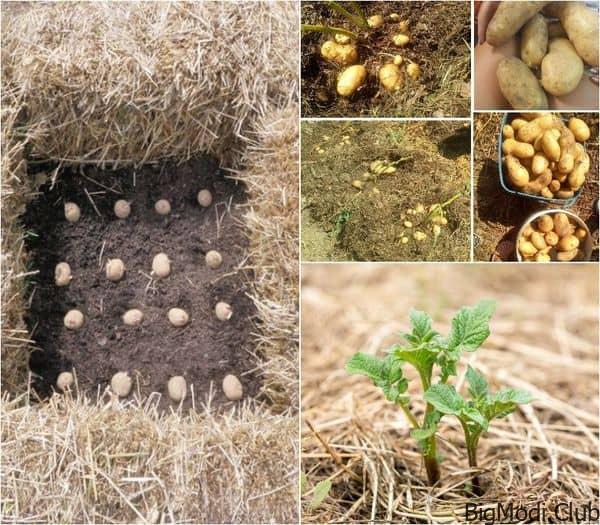Are you tired of the labor-intensive process of digging up potatoes? If so, growing potatoes in hay or straw might be your answer. This innovative technique simplifies both planting and harvesting while boosting the health and yield of your potato crops. Straw mulching—an approach that involves using straw or hay to cover your potato plants—offers a host of benefits, from enhancing soil fertility to reducing water evaporation. By opting for this method, you not only make your gardening efforts more efficient but also promote a more sustainable approach to agriculture. Discover how growing potatoes in hay or straw can transform your potato cultivation practices and lead to bountiful harvests.
Let’s delve into how straw mulching can revolutionize your potato farming.
The Benefits of Straw Mulching
Straw mulching offers several advantages for potato cultivation. By increasing the growth of beneficial soil bacteria, this method enhances soil health and productivity. Straw mulching improves soil humidity, reduces water evaporation, and cools the soil in hot, dry climates. As the straw breaks down, it adds valuable organic matter to the soil, which improves fertility and supports better potato growth.
A Greener Farming Practice
Integrating straw, particularly from rice and maize, into potato farming aligns with sustainable agriculture practices. This approach reduces reliance on chemical inputs, contributing to more eco-friendly farming by enhancing soil health and boosting yields. The use of straw not only promotes agricultural sustainability but also improves productivity.
Agronomic Advantages
The application of straw mulch has notable agronomic effects. It helps retain moisture, improves soil structure, and preserves nutrients—all crucial factors for increasing potato yields. This method ensures that your potatoes have the optimal growing conditions for better results.
Enhancing Soil with Organic Straw
Straw from cereals like wheat, rice, and maize is a valuable organic material. When used as mulch, it enhances soil quality, maintaining fertility and reducing the need for synthetic fertilizers. This practice supports long-term sustainability in agriculture by enriching the soil naturally.
Improving Potato Quality and Yield
Straw mulching positively impacts potato quality and yield. It enhances root development, nutrient absorption, and overall plant health, leading to better-quality tubers and higher yields. Additionally, it mitigates temperature-related stresses, further boosting productivity.
Nutrient Release and Timing
Straw mineralization—a process that takes between 2 and 10 weeks—is crucial for nutrient release. The type of straw used affects the timing of this release, which can significantly influence potato yield. Choosing the right straw and timing can optimize the benefits for your crops.
Economic and Environmental Benefits
Straw mulching proves to be economically advantageous as well. It significantly increases cultivation costs, gross and net monetary returns, and the benefit–cost ratio compared to unmulched methods. Moreover, it enhances soil moisture by up to 6% in the top 30 cm and stabilizes soil temperature fluctuations, providing a consistent growing environment.
Enhancing Soil Health
In addition to improving moisture retention and reducing soil erosion, straw mulching boosts soil biota, including earthworm populations and microbial activity. These enhancements contribute to overall soil health and increased potato yields.
Disease Control
Straw mulch also plays a role in disease management. It reduces disease severity by disrupting rain splash dispersal, a common method of disease spread. Furthermore, it minimizes aphid infestation and the transmission of viruses like Potato Virus Y (P.V.Y.).
Practical Aspects of Straw Mulching
Ease of Growing: Straw mulching simplifies potato cultivation by reducing the need for digging during planting and harvesting. This method not only makes harvesting easier but also maintains healthy plants throughout the growing season.
Weed Suppression: Straw effectively suppresses weeds, keeps the soil cooler, and gradually improves soil structure and fertility as it decomposes.
Preparation: Prior to laying down straw, prepare the soil by removing weeds and incorporating well-rotted organic matter such as compost. This preparation enhances soil quality and ensures a successful growing season.
Planting and Maintenance: Plant potatoes directly into the prepared soil, spacing them about one and a half feet apart. Cover them with straw to a depth of 2-3 inches (5-8 cm), using sticks or mesh to keep the straw in place. Water the straw to maintain consistent moisture.
Watering and Layering: Keep both the soil and straw consistently moist to prevent exposure to light. As plants grow, add another layer of straw, leaving just the tips of the foliage visible.
Harvesting: Begin harvesting new potatoes when the plants flower or wait until the foliage dies back for the full crop. The remaining straw, now partially decomposed, can be left to nourish the soil, used as mulch elsewhere, or added to the compost heap.
Organic Considerations: Ensure that the straw or hay used is organic or free from herbicide residues to avoid harming your crops.


